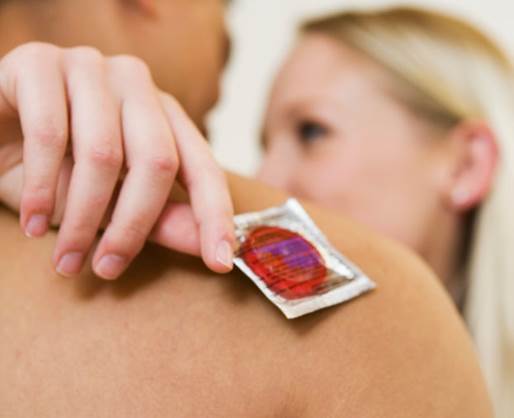1. Symptom: Pain during sex
Checklist:
Possible corresponding symptoms include lower abdominal pain, vaginal
discharge, a burning feeling when urinating and spotting between periods.
Could be:
Chlamydia
Which is: A
very common STI spread by unprotected sex with an infected person. Sometimes
referred to as ‘the silent infection’, it is carried by a lot of people who
have no idea they have it. There are often no symptoms at all.

Possible
corresponding symptoms include lower abdominal pain, vaginal discharge, a
burning feeling when urinating and spotting between periods.
What now:
See you GP for diagnosis. Tests usually involve a urine sample and occasionally
a cotton swab may be used for a localized test. Samples are then sent away for
analysis. An annual checkup is a good idea if you’re sexually active, even if
you don’t have any symptoms particularly if you have unprotected sex.
Treatment: A
single dose of antibiotics is enough to eliminate chlamydia if detected early.
A repeat dose may be necessary if you’ve had it for a while. You’ll need to
inform your sexual partner and have a follow up test three months later.
Left unchecked: It can result in pelvic inflammatory disease (PID), pelvic pain,
infertility, pregnancy in the fallopian tubes and in some cases be passed from
mother to baby, causing possible lung infections.
2. Symptom: Raised, painless growths ‚ around the vagina
Checklist:
growths may be flat, raised, singular or grouped together. They may also be
unseen inside the vagina, rectum or urethra.
Could be:
Genital warts

Raised,
painless growths ‚ around the vagina
Which is:
Genital warts are caused by the human Papillomavius (H PV), a very common STI
spread by direct skin contact or through sex.
What now: Diagnosis
is by way of a visual test by your GP or STI clinic. Your doctor can also talk
you through treatment options. A regular pap smear can pick up any
abnormalities with the cervix as a result of HPV
Treatment:
Treatment involves removing the warts themselves but not the actual HPV virus,
which can disappear once the warts do. Your doctor may suggest freezing the
visible warts off with liquid nitrogen or dry ice and/or using medicated lotion
for multiple warts. In some cases laser treatment may be recommended. With
treatment there is a good chance that the warts won’t come back but they can.
Left unchecked: HPV virus can affect the cervix and increases your risk of
developing cervical cancer.
3.
Symptom: Vaginal itchiness
Checklist:
Other possible symptoms include a yellowy green discharge, a burning sensation
or an unpleasant odor.
Could be:
Trichomoniasis
Which is:
Caused by the organism trichomonas vaginitis. A lesser-known STI, it’s
sometimes referred to simply as ‘trich’. There may be no symptoms at all.
What now:
Diagnosis usually consists of a vaginal examination and a swab of the area for
confirmation.
Treatment: A
large single dose antibiotic ¡s used to eliminate the infection which takes up
to three days to take effect. During this time you’ll need to avoid alcohol and
may experience bouts of nausea.

Diagnosis
usually consists of a vaginal examination and a swab of the area for
confirmation.
Left unchecked: Long term effects are more of the same, unpleasant symptoms. It is
also possible for the infection to resurface following treatment.
4.
Symptom: Small blisters around the
genitals
Checklist:
Other initial symptoms may include headaches, flu-like symptoms, tiny cracks in
the skin, a red rash, swelling in the genital region or pain when urinating.
Could be:
Genital herpes
Which is:
Caused by the herpes simplex virus HSV1 (usually found around the mouth but
also on the genitals) or HSV2 (mainly around the genital area). The virus is
spread by skin contact as well as vaginal, oral or anal sex.
What now: A
swab from the infected area will establish whether or not you have herpes. A
blood test may also be taken.
Treatment:
There is no cure but fortunately the virus only surfaces for short periods of
time after the initial infection. Treatment involves salt baths or antiviral
drugs that can reduce the severity of symptoms if treated at the first sign of
recurrence.
Left unchecked: It’s estimated that one in eight people live with the herpes virus
and up to 80 per cent of them have no idea they are infected.
5.
Symptom: An unusual discharge
Checklist:
may experience pain while urinating or symptoms associated with PID: pain
during intercourse, fever or heavy and painful periods.
Could be:
Gonorrhoea WHICH IS: Caused by Neisseria gonorrhoeae bacteria, gonorrhoea is an
easily transmitted and particularly resilient STI.
What now:
Testing for gonorrhoea involves a genital swab or urine test from your doctor
or STI clinic. It’s a good idea to have a test for gonorrhoea if you’ve
recently had a change of sexual partner or had multiple sexual partners.

Specific
antibiotics are used to kill off gonorrhoea, and often chlamydia as well.
Treatment:
Specific antibiotics are used to kill off gonorrhoea, and often chlamydia as
well.
Left unchecked: gonorrhoea can easily develop into PID where there is a serious
risk of reduced fertility or infertility. Your risk is further increased if you’ve
had PID previously.